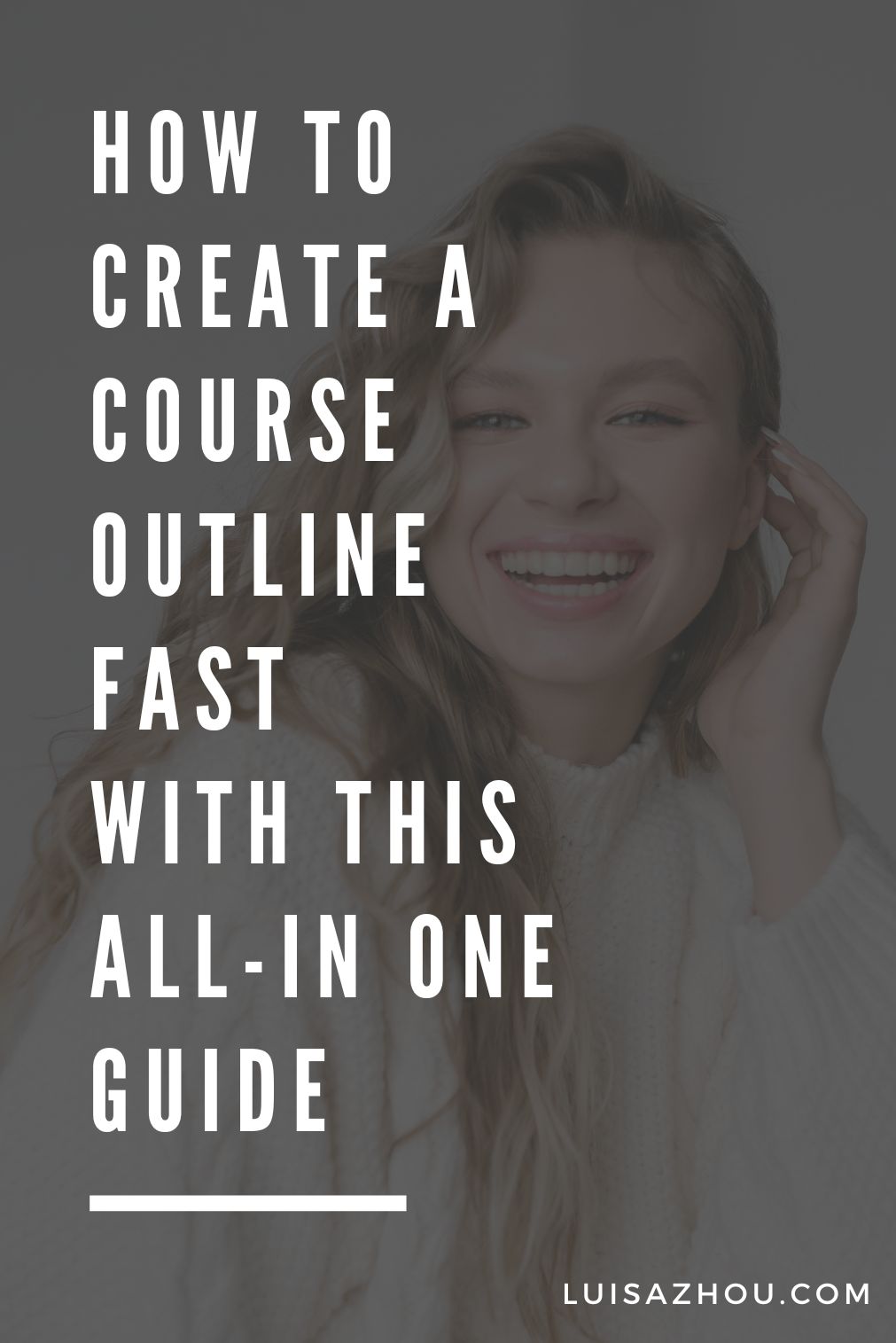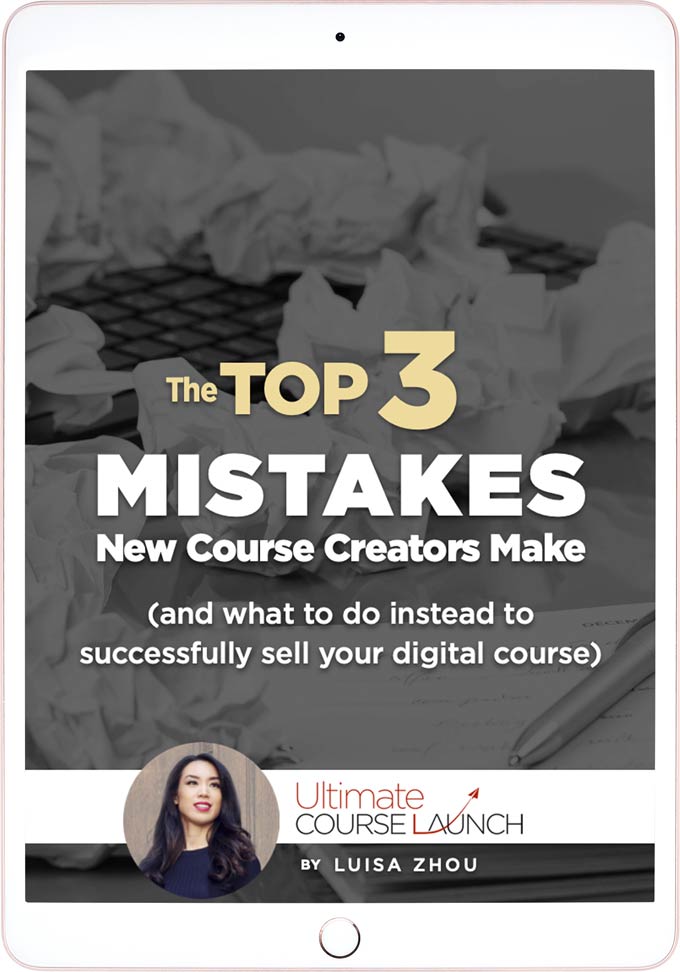Want to create an online course? The first step is to create your outline. And today, you’ll learn how to create an online course outline that will make your course stand out – in 2 hours or less.
Want to learn more? Read on!
In this guide, you’ll learn…
What is a course outline?
What should you include in a course outline?
How do you write a course outline?
Course outline template and example
Key takeaways: Online course outline
- Your course outline is a plan that helps you create an effective course.
- To create an outline you need to first define your students’ learning outcomes (goals) – this is the transformation your course offers.
- The goal of your course is to help your students achieve that transformation.
- A course is made of modules and lessons. Modules are the milestones your students need to go through to get to their transformation and lessons are the steps they take.
- Lessons are bite-sized and easily implementable and they consist of video, audio, PDFs, images, and other file formats.
What is a course outline?
An online course outline is a plan that includes all the information about how you’ll structure your course. You can create an entire storyboard or a simple list – the format doesn’t really matter.
Ultimately, a training course outline helps you create your course faster and better. It offers a map of your course for yourself and your students.
As a result, you as the course creator offer better results for your students.
And that helps you tap into the course market and build a thriving course business – one that helps you achieve so much more freedom, fulfillment, and abundance.
After all, it has become much more normal to start a course business, leave your job, and make 6-, even 7-figures.
Just look at the industry numbers; the global e-learning market is projected to be worth $325 billion in 2025. One of the leading online course platforms, Teachable, reports that in the past year, the number of Teachable creators earning 6-figures increased by 38% and 7-figures by 48%.
Courses can help you free up your time from money and if you have an existing business, they can help scale it.
Those are the real benefits of a course.
Just like my student Emily who is a career coach – she created her course “Happily Hired” to help people achieve their career goals.
Or Ruby, who is a relationship coach and helps men find love with the help of online courses.
But to do so, you need to learn how to create your online course outline – and that’s what we’ll look at next.
What should you include in a course outline?
An effective course outline should include:
- Course name: Include your course name in your outline.
- Course description: Describe your course and what the end goal is that people get when they go through your course. Include the learning objectives here.
- Course schedule: Include a schedule that outlines when you’ll create each step of the course.
- Modules: Include your modules.
- Lessons: Add the lessons you’ll include under each module.
- Bonuses: Include an overview of the bonuses you’ll include.
- Assessments: Include assessments (like a quiz at the end of a module) (optional).
Here’s an example template you can use:
Name:
Description:
Module 1
Name:
Description:
Lesson 1
Name:
Description:
Lesson 2
Name:
Description:
Lesson 3
Name:
Description:
Module 2
Name:
Description:
Lesson 1
Name:
Description:
Lesson 2
Name:
Description:
Lesson 3
Name:
Description:
Module 3
Name:
Description:
Lesson 1
Name:
Description:
Lesson 2
Name:
Description:
Lesson 3
Name:
Description:
Module 4
Name:
Description:
Lesson 1
Name:
Description:
Lesson 2
Name:
Description:
Lesson 3
Name:
Description:
Bonus 1:
Bonus 2:
Bonus 3:
Bonus 4:
Note: You’ll get a fillable course template document at the end of this blog post.
Now you have a course outline “skeleton.” But how do you implement it? Here’s how to write your course.
How do you write a course outline?
How do you choose your modules, lessons, and structure your course?
It’s simpler than you might think. Sit down and brainstorm these steps:
1. Understand your target audience
2. Define your learning outcomes
3. Identify the main milestones
4. Name your course
5. Plan your modules and lessons
6. Decide on your course bonuses and assessments
Remember: Your outline isn’t necessarily the final outline you’ll use because you might end up modifying it based on student feedback. But it still gives the overall picture of what your course will teach and its outcomes.
Step 1: Understand your target audience
First, understand who your ideal clients are. Identifying your course target audience is crucial for your outline. After all, your course teaching style will change depending on your audience. (Are your students adults? Kids? Teens? College students? Corporate professionals? Small business owners?)
And you need to know how to talk to them about your course. If you use jargon or technical terms or go into technical details too soon, you might confuse your audience, depending on who they are.
In other words, understand:
- They goals
- Their knowledge level
- What their challenges are
One great way to get to know your audience on that level is to first work with approximately three private coaching or consulting clients. By working with different people, you see what the patterns are, where people typically get stuck, and so on.
You also need to understand the problem your course solves.
Let me explain:
Your course topic does one thing: it solves a problem that people care so much about that they’re willing to pay for it.
For instance, for some people, learning how to bake sourdough bread isn’t something they’d pay for. But other people really care about their lack of sourdough baking skills and they’re willing to pay for a course that teaches them how to do it.
Ask yourself: what problem does your course solve? Is there a paying audience for that topic?
When you know what problem your course helps to solve, you can create a course outline that focuses on that one thing.
Step 2: Define your learning outcomes
Once you know your audience and the problem you solve, the next step is to get clear on your course’s learning outcomes.
You see, the transformation you offer is the most important part of your course so don’t skip this step.
However, this part doesn’t have to be very long; a few sentences are enough. Like this:
“(Your course name) teaches you how to (your course topic) so that (goal).”
That said, make sure those learning objectives are specific and, if possible, measurable (for example, will your students be able to lose a number of pounds or earn a higher salary?).
Even intangible topics can have measurable outcomes. A course on self-confidence can help people increase their income and a course on stress relief can help people sleep for longer at night.
That said, learning outcomes don’t need to be tangible. A course on happiness can be extremely effective, but there’s no measurable outcome. In that case, focus on those specific outcomes happiness can bring, like a better relationship with people around you, lower stress, and improved health.
In this video, I share a few more thoughts on the subject:
Step 2: Identify the main milestones
The next step to creating your perfect outline is to identify the main milestones that your student is going to pass through while following your course. These milestones support the overall goal they’re working towards and they constitute the course modules or course requirements someone needs to go through to achieve that goal.
Every milestone also has sub-milestones.
In other words, if your course requires students to achieve certain subgoals before they can move on to the next module, you’d organize your outline according to those goals.
For example, if your course teaches how to build a savings account, the milestones might be getting out of debt, then saving your first $100, then saving your first $1,000.
The second way to organize your content is through distinct areas of mastery. These milestones might not necessarily be part of a linear process, but they are distinct areas or benchmarks that your student will have to master before being able to reach the final destination.
For example, if you’re creating a course on how to play tennis, you might organize your content around the 5 different stroke types, with one module each on the serve, the forehand, the backhand, the volley, and the overhead.
By organizing your course in this way, you’ll know what to include in each module.
I talk more about organizing your course in this video:
Step 3: Name your course and describe it
Before you create your modules, you need a course name.
Think about words related to your course. You don’t want to be too creative here; instead, use a clear name. A few examples include my own courses (Employee to Entrepreneur, Your First Paying Clients, and Ultimate Course Launch).
Also, include a brief course description. You can use the learning outcomes you brainstormed in the previous step as your course description.
Step 4: Plan your modules and lessons
The next step is to plan your modules and lessons.
Your course needs to be easy to follow so that your students achieve their learning outcomes.
A common mistake many first-time course creators make is to include as much as they can in their course because they mistake information for value.
But your students don’t care about how many lessons you include or how many PDFs they get. They care about results.
And that’s why the best courses include only the information people need to implement it and get results.
To be easy to implement, your course should include 4-8 modules. And each module should have no more than 3-7 lessons.
Fill in the course outline template with your modules based on the milestones and sub-milestones you defined earlier in this section.
For example…
Module 1: Saving your first $100
Lesson 1: Shift your mindset around money
Lesson 2: Reduce your spending
Lesson 3: Create a spending plan
Lesson 4: Pay off debt
When creating your lessons, add:
- An introduction in each lesson where you tell students what they’ll learn in that lesson
- A summary of the main takeaways and of the steps your students should take next at the end of each lesson
Overall, you deliver the best results by including results-focused content that isn’t just information. Make it bite-sized so that it’s easy to take in – again, pure information isn’t the same thing as value.
You also need to specify how you’ll deliver the content.
Are you using audio, video, or text? Or a combination of all of them?
Most online courses that cost $100 and up tend to use a combination.
The different content types are…
- PDFs: These are typically bonus material like eBooks or worksheets or supporting material like lesson summaries.
- Slides: Slides help you walk your students through different steps.
- Screen recordings: These types of videos are effective for tutorials.
- Talking head videos: If you want to build a more personal relationship with your students, talking head videos can work really well.
- Audio: Audio files can be “mini courses” within your course or supporting audio file material.
Next, let’s look at what supporting material you should include in your course.
Step 6: Decide on your course bonuses and assessments
Finally, you need to include bonuses so that your course offer feels like a no-brainer for your students. Your bonuses depend on your course, but a few examples include:
- Results trackers
- Templates
- Scripts
- Case studies
- Bonus lessons
Include a list of your bonuses in your outline.
Also, if your course includes assessments, such as quizzes, include them here, along with any student learning resources.
And with that, you’re done with your outline!
Bonus: Do this after you’re done with your course!
While you DO need a course outline to sell your course (to know WHAT you’re selling), you shouldn’t create your course material just yet. Let me explain…
To successfully sell your first course, you need to start with the smallest course possible.
Too many aspiring course creators try to turn their first course into a complete flagship course with all the bells and whistles. Which ends up by way too overwhelming to create and sell.
Instead, focus on a “First Steps” course that makes it way easier for you to create, sell, and over-deliver on it.
A First Steps course teaches the first steps people would need to take to achieve their ultimate goal. For example, when I created my first online course for this business, I sold a course called “Your First Paying Clients” (YFPC). Once I had sold that course, I moved on to my flagship course, “Employee to Entrepreneur” (ETE).
YFPC teaches how to get your first client and is far less comprehensive than ETE, which outlines the entire process of starting a business while in a full-time job.
What’s more, you don’t create your course right away. Instead, start with the outline and the first module before you sell it.
Once you’ve pre-sold it to your first students, you create the rest of your course in real time, based on student feedback.
This way, you create the best course on your topic because it’s based on what students actually want. (So to be super clear, you’ll create a rough outline so that you know what you teach in your course and then add or remove things as you teach your course.)
Now, if you feel you absolutely want to create your course before selling it, you can. But make sure you’re not just doing it because you think that’s going to be higher value or more “perfect.”
Because it might be the opposite. Most course creators have experience with the subject they’re teaching, but not so much experience actually teaching it. When you create your course based on live feedback, you’re able to create the best value and experience for your clients.
Online course outline template and example
Now you know how to fill out your outline.
Want a template to get started?
Here’s a fillable document with the course outline template.
And if you want an example, here’s one on how to get out of debt (note that this is just an example):
Module 1: Foundations for a debt-free life
- Lesson 1.1: What is debt?
- Lesson 1.2: The biggest debt mistakes people make
- Lesson 1.3: The psychology of debt
- Lesson 1.4: Assessing your debt
Module 2: Planning and budgeting
- Lesson 2.1: Setting financial goals
- Lesson 2.2: Creating an effective budget
- Lesson 2.3: Reducing your expenses
- Lesson 2.4: Track your spending
Module 3: Debt repayment plan
- Lesson 3.1: The snowball vs. avalanche methods
- Lesson 3.2: Consolidation and refinancing options
- Lesson 3.3: Negotiating with creditors
- Lesson 3.4: Saving vs. paying off debt
Module 4: Increasing your income
- Lesson 4.1: Side gig ideas
- Lesson 4.2: Setting up your side gig
- Lesson 4.3: Allocating your side gig income
Module 5: Managing credit
- Lesson 5.1: Understanding credit scores and reports
- Lesson 5.2: Improving and maintaining your credit score
- Lesson 5.3: Steps to using credit cards
- Lesson 5.4: Do this with collections and defaults
Module 6: The long-term plan
- Lesson 6.1: Building an emergency fund
- Lesson 6.2: Invest your money
- Lesson 6.3: Retirement planning
Module 7: Avoiding future debt
- Lesson 7.1: Course correcting your financial habits
- Lesson 7.2: Building in financial check-ins
Next steps
There you have it! Now you know how to create an online course outline.
What it comes down to is that you create a comprehensive outline that you can modify as you create your course.
That said, creating your outline is the FIRST step in the course creation process.
But there are plenty of mistakes first time course creators tend to make.
Want to know what they are?
Get my free blueprint on the three deadly mistakes course creators make.
Learn more:
How to Launch Your Online Course
How to Price Your Online Course








